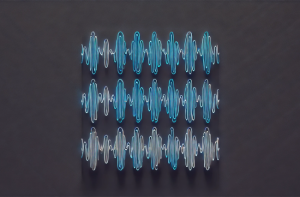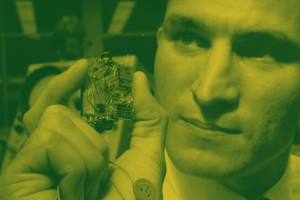How to Read People’s Minds?
On neurointerfaces, robotic arms, brain research, and reading intentions

Perhaps, the best description of the research of our laboratory would be on the two different aims: one is the fundamental research that we do, and the other is the potential applications of our findings. And within the context of how we approach biological problems, this is a more accurate description of our work. From this vantage point, 80% of what our laboratory does is fundamental research. What we are interested in within this context is sensory biology – how animals, including humans, sense their environment, and, in particular, we work on the senses of hearing and balance. Somatosensation is another topic that we work on. We are interested in how somatosensory systems are built during embryonic development, how they are maintained throughout the life of an animal, and also, when there is a damage –physical, metabolic, or from an infection –, how the peripheral sensors or neural circuits that communicate the information to the brain can handle that damage, whether they can naturally regenerate them and restore their function. If regeneration cannot occur naturally, we investigate whether we can influence and coach these systems to regenerate. Physical injury and metabolic stress are the two challenges that we present to the animals, and then we study repair and regeneration.
This work on neuronal reparation was motivated by a particular problem in zebrafish – this is an experimental system that we use to test technologies, as well as in mammals, including humans. The problem is as follows: there are many neurons that cannot repair themselves after injury. If there is damage to these neurons, they remain alive but defective in that the communication between the neurons and the brain is blocked. There is a reason for this lack of repair, and this is the fact that these neurons have a very low capacity to re-grow axons or dendrites.
Over the years, many researchers have found out that there is an intracellular process that relies on one the second messenger called cyclic adenosine monophosphate (cAMP). Intracellular cAMP is able to promote the re-growth of axons in regeneration-refractory neurons. The problem with technical approaches that attempt to elevate the levels of cAMP in cells is that they rely mostly on pharmacology, and using pharmacology, you don’t have much control over where your drug is acting. Thus, you are inducing axonal regeneration, but at the same time, you are modifying circuits uncontrollably and on a systemic level.
To overcome the limitations of pharmacology, we developed a method that uses light that we can shine on specific cell types, including individual cells, to elevate cAMP on the cells of interest, but also when and for as long as we want. This technology relies on a set of tools that are called ‘optogenetics’. It is powerful because it allows you to have total control over where and when you promote axonal regeneration.
For that, we used the fact that is that in many microorganisms, light is a powerful source of information. Bacteria, in particular, have evolved enzymes that respond to light. And there is one soil bacterium in particular that has an adenylyl cyclase that responds to blue light. This is a natural enzyme; it has not been genetically modified by us. We figured that if we can make neurons produce this bacterial adenylyl cyclase – the enzyme that produces cyclic AMP – then we can potentially use light to activate it in those neurons. And what we did was to produce a codon-optimized version of blue-light activatable adenylyl cyclase called bPAC for this protein to be produced in eukaryotic cells. We made this enzyme be produced in the whole fish and then shone blue light on them, and observed that we could elevate cAMP systemically.
After that, we made this enzyme to be expressed specifically in neurons; we then came with an ultraviolet laser, cut their axons inside the fish, and then looked at their regeneration capacity. If the fish were kept in the dark, no blue light was shone on them, we had only about 5% axonal regeneration, but we could increase their regeneration by 6-fold if we shone blue light on the fish.
One thing that we do, and this has not been published, but I am happy to disclose it, is that there is one particular disease – diabetes – that blocks the normal function and regeneration of many neurons, and that leads to a severe problem of late stages of diabetes that is called ‘diabetic neuropathies’. Eventually, these neuronal defects lead to chronic pain, loss of sensation, and, eventually, amputation of a limb. What we are now testing is how good our system is at promoting the recovery of neurons that are affected by hyperglycemia – which is one of the main problems that arise from diabetes.

One of the limitations is that the technology still relies on transgenesis. If we think about potential clinical applications of this technology, we face a technical and an ethical problem, that is, how to, and whether we should, express transgenes in a human patient. It’s the same problem as that of gene therapy in general. It is a bit of a problem. The third problem is that the most effective tool to promote regeneration, bPAC, is optimally activated by blue light, and high doses of blue light are damaging to tissues. Also, biological tissues have a high level of scattering for blue light, so blue light doesn’t penetrate well. Ideally, we would like to have photoactivatable adenylyl cyclases that respond to longer wavelengths, in particular in the red or infrared spectra. Because infrared light is milder, it doesn’t damage tissues as much as blue light, and it penetrates much better. Now if we think about potential uses of this approach to induce regeneration of neurons that are 2 centimeters deep in a patient, then we would definitely need infrared light activation. A potential solution to the problem of transgenesis is not to use optogenetics but optochemistry. However, that’s all in development and so far in its infancy.
There are several ways by which optochemistry can work, but one promising approach involves giving an animal or a patient an inert compound that on its own will be unable to do anything, but when activated, it will trigger one specific response in cells. And one of the things that could activate is endogenous adenylyl cyclases. Now, the way to transform this inert compound into an active one would be to use light. So that even though this compound will be distributed in the whole body of the organism, we could use light to activate it exclusively in the area or the organ that we want. One possibility is to use compounds that are ‘caged’. A chemical ‘cage’ around the active compound will not allow it to function, but light could break this cage or open the cage to liberate the compound when and where you want. One already tested approach is that a cage will be degraded by light. That’s been tested already for some things. The approach is called ‘photo-uncaging’, and there is ample literature on it. That’s one potential approach.
On photo-uncaging of compounds, there is rich literature. I am not aware of any work that has got to clinical or pre-clinical stages. But in fundamental work, there’s a lot published already.
– There’s work that used optogenetics in cell biology, stem cells, and metabolism. In addition, there’s some work on biochemistry that has benefited from optogenetics. So, it has found applications beyond neuroscience.
The future of the field, I believe, is a continuous advance of the technical aspects. Optogenetic actuators will get better. They will get better in that they will be easier to work with, they will be faster, and we will be able to use them in more complex systems and organisms. So that’s one aspect of the field that has if we are allowed to use the word, a ‘bright’ future. The other aspect that has an open future, but is always going to be more challenging and slower, is the application to the clinic. So far, there is not much done in that field, at least, not much success reported, but I think there’s a lot to be done, and that’s where, I would say, the field will see more advances.
What we’re going to do is to try to use the same optogenetic approach to address two problems: one is biological – to see the extent to which we can recover not individual cells but whole circuits that have been damaged. And as well as how much functional or behavioral recovery there is in the animal. The second is to extend beyond our main experimental system and see how well we could replicate our zebrafish results in mice, for example, or rats. Especially in animals with spinal cord injuries. This is a big challenge; it’s a problem that in human patients so far has not been solved – paralysis derived from spinal cord damage is difficult to overcome. And so, down the road, I can see that our approach, our technology, could be applied to recover spinal cord injuries in mammals.

On neurointerfaces, robotic arms, brain research, and reading intentions

Neurotransmitters, neurointerfaces, and senses that humans have never experienced before

Neurologist Kevin Talbot on the RNA transport down the axons, spinal muscular atrophy and why human motor neur...